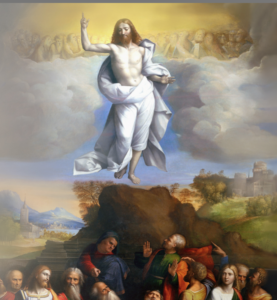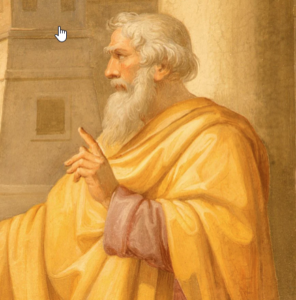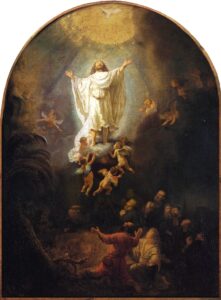"No one has ever ascended into heaven except the one who descended from heaven."
St. Augustine
The Solemnity of the Ascension of the Lord commemorates the fortieth day after the Resurrection when Jesus ascended body and soul into Heaven and took His seat at the right hand of His Father. Traditionally, the location of the Ascension is believed to be less than a mile east of the Old City of Jerusalem, and that spot is marked by the Chapel of the Ascension, which is said to contain a miraculous imprint of the footprints of Christ before He ascended. The event of the Ascension is found in the Gospels and Acts (Mark 16:19–20; Luke 24:50–53; Acts 1:6–12). It is also alluded to in various other passages (John 6:62; Ephesians 4:7–10; 1 Timothy 3:16; 1 Peter 3:21–22).
 Only Jesus and His Blessed Mother have entered into the glories of Heaven, body and soul. Jesus’ Ascension implies that He did so by His own authority and power. The Blessed Virgin Mary’s Assumption implies that she entered Heaven, body and soul, by God’s power, and not her own.
Only Jesus and His Blessed Mother have entered into the glories of Heaven, body and soul. Jesus’ Ascension implies that He did so by His own authority and power. The Blessed Virgin Mary’s Assumption implies that she entered Heaven, body and soul, by God’s power, and not her own.
The Ascension marks the completion of Jesus’ earthly mission. He first united His divine nature with human nature through the Incarnation at the moment of the Annunciation. Saint Thomas Aquinas teaches that from that moment on, Jesus, the Son of God, experienced three types of knowledge. First, being God, He had beatific knowledge, that is, a direct knowledge of His essence, the Father’s essence, and the Holy Spirit’s essence. Second, He had the perfection of infused knowledge, that is, a bestowal of all truths given to the angels in Heaven, especially those truths necessary for the completion of His divine mission. Third, He began to acquire learned knowledge, or experiential knowledge. This was the form of knowledge attained through His human nature from the senses and His human reason.
As Jesus fulfilled His mission through life, His learned knowledge continued to grow until it was perfected in human form. It was never imperfect in the sense of sin, but only in the sense of growth through human experience and human love. He experienced all things, allowed the perfection of His beatific and infused knowledge to guide His human experiences and brought those human experiences and knowledge to perfection. His free embrace of the Cross manifested the perfection of divine love in human form, and His Resurrection brought that perfect unity of human and divine love to a new and transformed resurrected state of human existence. But that was not all. Today we commemorate the fact that Jesus took His perfected human nature into the Beatific Vision, enabling humanity itself to follow. The Blessed Virgin Mary was the first to do so given her sinless state.
The final stage of the salvation of humanity will take place when Jesus returns to judge the living and the dead. At that time, every human body will rise, will endure the final purification and transformation, and will share in the new and resurrected state in which the faithful will be able to stand, body and soul, before the Most Holy Trinity and experience the fullness of the Beatific Vision forever. What Jesus has already accomplished in His human form is what we look forward to in hope at the end of time.
The Feast of the Ascension was celebrated annually from as early as apostolic times. Saint John Chrysostom, Saint Gregory of Nyssa, and Saint Augustine all attest to this fact. When the Council of Nicaea set the date for the celebration of the Resurrection in 325, it chose to keep Easter on the first Sunday after the first full moon occurring on or after the vernal equinox in spring. This decision also set the day for the Ascension being forty days after Easter, on a Thursday. Today, many ecclesiastical provinces transfer the Thursday celebration to the following Sunday to provide for a wider celebration.
Though every aspect of Christ’s life is shrouded in mysteries which will only be fully understood by the faithful when they stand before Him and behold the Beatific Vision, today we especially ponder this beautiful and profound mystery of our faith. As we celebrate the Ascension, try to prayerfully meditate upon the perfect unity of Jesus’ human and divine natures. Ponder further the truth that because the Son of God is both God and man, and He beholds His Father and the Holy Spirit as both God and man, He invites each of us to begin to share in that glorious vision. Only after we fully die in and with Him and rise to new life in and with Him will we be able to know Him clearly and share in His glorious resurrected and ascended life. Until that moment comes, it’s important to ponder that which is incomprehensible. We must know that we do not know, believe what is beyond belief, hope in that which is more than we can understand. God is a mystery; the Ascension is a mystery—but they are mysteries that must be penetrated by prayer. Do so today as we commemorate this holy culmination of the earthly life and mission of Christ.
From a sermon by Saint Augustine, bishop
(Sermo de Ascensione Domini, Mai 98, 1-7: PLS 2, 429-495)
 No one has ever ascended into heaven except the one who descended from heaven
No one has ever ascended into heaven except the one who descended from heaven
“Today our Lord Jesus Christ ascended into heaven; let our hearts ascend with him. Listen to the words of the Apostle: If you have risen with Christ, set your hearts on the things that are above where Christ is, seated at the right hand of God; seek the things that are above, not the things that are on earth. For just as he remained with us even after his ascension, so we too are already in heaven with him, even though what is promised us has not yet been fulfilled in our bodies.
Christ is now exalted above the heavens, but he still suffers on earth all the pain that we, the members of his body, have to bear. He showed this when he cried out from above: Saul, Saul, why do you persecute me? and when he said: I was hungry and you gave me food. Why do we on earth not strive to find rest with him in heaven even now, through the faith, hope and love that unites us to him?
While in heaven he is also with us; and we while on earth are with him. He is here with us by his divinity, his power and his love. We cannot be in heaven, as he is on earth, by divinity, but in him, we can be there by love.
He did not leave heaven when he came down to us; nor did he withdraw from us when he went up again into heaven. The fact that he was in heaven even while he was on earth is borne out by his own statement: No one has ever ascended into heaven except the one who descended from heaven, the Son of Man, who is in heaven. These words are explained by our oneness with Christ, for he is our head and we are his body. No one ascended into heaven except Christ because we also are Christ: he is the Son of Man by his union with us, and we by our union with him are sons of God.
So the Apostle says: Just as the human body, which has many members, is a unity, because all the different members make one body, so is it also with Christ. He too has many members, but one body. Out of compassion for us he descended from heaven, and although he ascended alone, we also ascend, because we are in him by grace. Thus, no one but Christ descended and no one but Christ ascended; not because there is no distinction between the head and the body, but because the body as a unity cannot be separated from the head.”
https://www.vatican.va/spirit/documents/spirit_20010525_agostino_en.html
Why Did Jesus Ascend to Heaven?
Ascension Thursday and Pentecost: What's the Connection?
The Ascension Dr. Pitre
Prayer
God our Father,
make us joyful in the ascension of your Son Jesus Christ.
May we follow him into the new creation
for his ascension is our glory and our hope.
We ask this through our Lord Jesus Christ, your Son,
who lives and reigns with you and the Holy Spirit,
one God, for ever and ever.
The Kerygma:
“The kerygma — the proclamation of the Good News — is not a ‘traditional’ custom or a certain ‘social practice.’ The kerygma is the joyful announcement that Jesus Christ is a living Person to be encountered, who through his Resurrection has defeated sin and death.”
The term κήρυγμα (kerygma) is a Greek word meaning “proclamation.” The Greek word κηρύσσω (kerysso) means “herald,” or one who proclaims. And thus the kerygma is what is proclaimed.
As the Apostles began the work of preaching and proclaiming Christ, they proclaimed a message that was rather basic and simple. More extended teaching or instruction would come later, after baptism. But the initial proclamation of Christ was simple and to the point.
7 Messages of the Kerygma:
- God loves you and has plan for your life. – Yes, God the Father loves you and seeks you. And that ache in your heart, that longing, that yearning, and that “never satisfied” quality in your desires all point to God and he has written his name in your heart. He wants to turn you away from a passing and unsatisfying world, towards him. He wants to save you and prepare you to live with him for all eternity. He wants to fill the God sized hole in your heart and its infinite longing with his infinite Love. (CCC 1).
- Sin will destroy you. – Nothing is so destructive in your life and this world as sin. It is desire gone wrong, it is rooted in the lie that the creature rather than the Creator can help and save us. Cultivating sin will put you in bondage to desires gone mad that will not ultimately be satisfied. Satan is lying to you and saying that rebellion form the One who made will bring happiness to you. It will not. And you know this already don’t you? Sin and indulgence does not ultimately satisfy. The world cannot satisfy, for it is finite and your desire is infinite. Sin does not ultimately bring happiness, it brings bondage, addiction, dissatisfaction, and ultimately resentment and spiritual death.
- Christ Jesus died to save you. – Into this mess of our wayward desires and our foolish grasping at worldly trinkets Jesus came. He met the woman at the well (who is us) and told her that every who drinks form this well (the world) will be thirsty again. In other words, the world cannot ultimately satisfy or save us. We must die to this world and rise to God. But our way to God was cut off by sin. Jesus came and reopened the way to the Father by dying to this world, to its lies and false claims. Rising and Ascending he has re-opened the way to the Father, our hearts true desire. Now we can be saved by being led back to the Father by the saving power of Jesus. And dying to this world, we can one day fully be satisfied by God.
- Repent and believe the Gospel. – To repent means to come to a new mind, to come to understand and accept all that has been stated: that the Lord loves me, is calling me in my desires, and want to save me from the sinful drives that will destroy me. It is time for me to come to believe in this Love God has form me and accept the promise and salvation of his love: Jesus Christ and the saving truth he proclaims.
- Be Baptized and receive the Holy Spirit. – And thus in Baptism our sins are washed away, we are incorporated into Christ, we become a member of his body. And having done so, the Holy Spirit, the life, love, serenity, joy and wisdom of God comes to dwell in me and begins a work of transforming me, that includes the other Sacraments as well.
- Abide in Christ and his body the Church. – Grow in this relationship with Jesus and His Father in the Holy Spirit by living in the life of the Church, which is Jesus presence and Body in this world. Abide there, that is go on dwelling there.
- Go make disciples. – And so the cycle repeats with the newly Evangelized and more deeply rooted Christian calling others.
